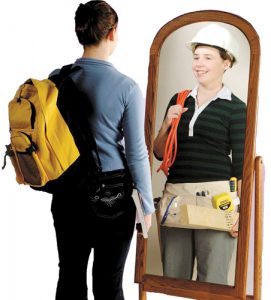
Programs focus on showing young women non-traditional careers
It’s the best-kept secret in the province.
So says Skills Canada-Ontario’s executive director Gail Smyth.
She sits at a registration table for the Skills Work! For Women logging all the attendees for a career event geared towards young women in grades 9-12.
“One of the things that’s really important is that young women don’t know about these careers,” she says of skilled trades. “I’ve often had people say to me, ‘I wish more young women were choosing a career in construction or choosing a career in manufacturing’.”
The traditionally male-dominated industry is seeking new blood, and with a depleted force expected to hit 364,000 jobs by 2025, girls have the choice to enter a high-paying, life-long career.
“I think that the shortage of workers in the skilled trades and technologies are providing more and more opportunities for young women,” Smyth said. “That’s what (Skills Work! For Women) is all about.”
Esteemed workers from various industries network with teenage girls in the hopes that it will raise the profile of the trades.
But it’s the lack of promotion outside of Skills Canada that concerns Smyth.
“Either their parents aren’t in that field, or no one in their family is in the skilled trades,” she says. “I think the more information, the more guidance we can provide these young women, the more successful we can be in encouraging them to look at these careers.
“If they go through an apprenticeship they don’t have to worry about paying back huge debts because they are getting paid as they go to school and they’re learning.”
After apprenticing, girls have the opportunity to pursue a career mentor like Judy Bartley, a first line manager at Ontario Power Generation.
She shares Smyth’s passion for the trades, but her inspiration to teach comes from a different source: her two daughters ages 20 and 22.
“I see women taking a more predominant role so that there’s a 50-50 (split),” Bartley said. “I think (there’s) the confidence that (girls) can do it.”
Though she admits she hasn’t experienced too many obstacles on her chosen career path, Bartley points to some academic challenges girls may face.
“They get scared of doing their maths,” she said, adding once girls conquer calculus and trigonometry, “they can do whatever they want, and they can be the best they can.”
But for teenagers Kaitlyn Endicott and Bridget Norcia, no troublesome equations detour them from their career path pursuit.
“It’s more to see what opportunities are out there because I guess when you’re a kid you’re sort of strayed with your parents saying, ‘Doctor, lawyer, teacher, whatever’, but you don’t realize all the other choices are out there,” Bridget said.
Kaitlyn agreed, adding it “definitely builds your confidence” attending the networking dinners.
Back at Skills Canada-Ontario’s office, spokesperson Carolyn Hartlen works at dispelling many of the myths associated with a dirty industry.
“There’s that mindset that if (kids) can’t do anything else, they can certainly get a construction job after high school,” Hartlen said. “That is not the case today. There are such advancements in supplies, technologies.”
But she adds there are still plenty of hurdles to jump over before skilled trades see more females among the ranks.
“It’s quite evident that we’re still looking at a low percentage of young women that are considering trades compared to young men — without a doubt that still continues,” she said. “However, if we look at the change in young women: how vibrant and confident, and willing to choose things that are non-traditional.
“They are looking for ways to sustain themselves independently, the skilled trades certainly offer that.”
Minister of Training, Colleges and Universities John Milloy agreed in a recent interview at the Town Crier office.
“There’s a lot more work to be done and one of the things we have envisioned as far as the trades is as well as a general mandate to welcome more young people and welcome more young people to go into the trades, it is also to look at those groups that are underrepresented … in so many apprenticeship fields,” he said. “They’re going to have a very, very specific mandate to develop policies and programs that will attract more women to the trades.”
Still, a trend has been forming ever since Skills Canada entered the classroom through their in-school program.
“In ’98 I started at an in-school presentation program I said, ‘If we did 10 presentations that year to high schools across the province, that would be successful,” Smyth said. “We’re now doing 1,000 presentations across the province every year, 84 percent of all the high schools in the province of Ontario are affiliated with us, 50 percent of all elementary schools and 100 percent of all colleges.”
